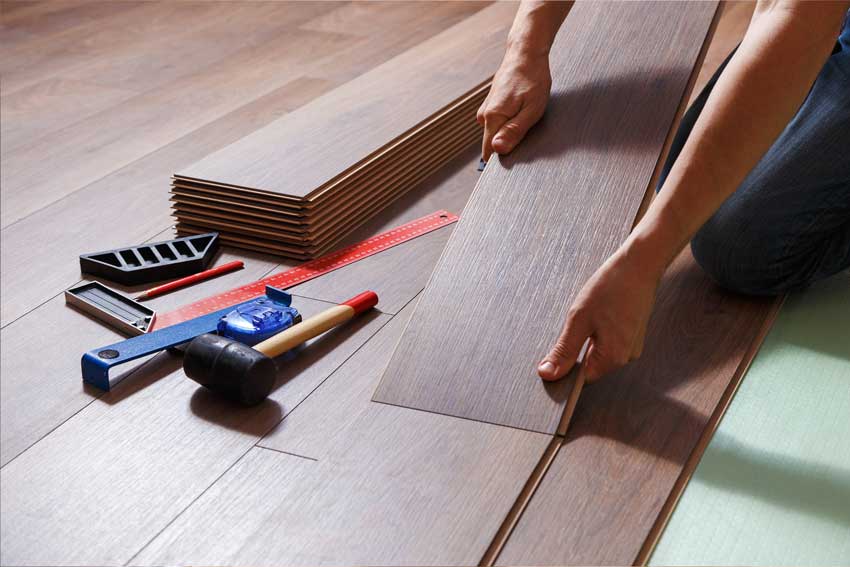Introduction to Flooring Installation
Flooring installation is a significant home improvement project that requires careful planning and execution. Whether you’re installing hardwood, laminate, tile, or carpet, following the correct process is essential to avoid common pitfalls and ensure a seamless finish. This guide aims to provide you with a step-by-step approach to flooring installation, helping you understand each stage and what it entails. By the end of this article, you’ll have a clear roadmap to achieve professional-quality flooring in your home.
The importance of proper Flooring Installation Services cannot be overstated. Improper installation can lead to numerous problems such as gaps, warping, and premature wear, which can compromise the look and functionality of your floor. Therefore, taking the time to understand and follow the best practices for flooring installation is crucial for long-term satisfaction and value. Whether you are a DIY enthusiast or planning to hire professionals, this guide will equip you with the knowledge needed to ensure a successful flooring project.
Preparation: The Foundation of a Successful Installation
Assessing the Subfloor
The first step in the flooring installation process is assessing the subfloor. A stable and even subfloor is crucial for the longevity and performance of your new flooring. Inspect the subfloor for any damage, such as cracks, moisture, or uneven areas. Repair any issues before proceeding with the installation. A well-prepared subfloor ensures that your flooring will be level and free from movement, which can prevent future problems like buckling or warping.
Assessing the subfloor also involves checking for the type of subfloor material, whether it’s concrete, plywood, or another type. Each type may require different preparation methods and materials for the flooring installation. For example, concrete subfloors may need a moisture barrier, while wooden subfloors might need additional leveling or reinforcement. Understanding the specific needs of your subfloor will help you choose the right preparation techniques and materials, ensuring a solid foundation for your flooring.
Gathering Necessary Tools and Materials
Before you start the installation, gather all the necessary tools and materials. This includes the flooring material, underlayment, adhesive (if required), spacers, a tape measure, a utility knife, a saw, and a hammer. Having all the tools on hand will streamline the installation process and prevent unnecessary delays. Make sure to read the manufacturer’s instructions for any specific tools or materials recommended for your chosen flooring type.
Additionally, preparing a checklist of tools and materials can be helpful. Ensure you have safety equipment like gloves and goggles, as well as cleaning supplies to keep the work area tidy. Organizing your tools and materials beforehand not only makes the installation process more efficient but also minimizes the risk of errors and accidents. Proper preparation sets the stage for a smooth and successful flooring installation, saving time and reducing frustration.
Acclimating the Flooring
Many flooring materials, especially hardwood and laminate, need to acclimate to the room’s temperature and humidity before installation. Place the flooring in the installation area for at least 48 hours to allow it to adjust. This step is crucial to prevent the flooring from expanding or contracting after installation, which can lead to gaps or buckling. Proper acclimation ensures a stable and long-lasting floor.
Acclimating the flooring also helps to balance moisture levels in the material, reducing the risk of moisture-related issues such as cupping or crowning. This is particularly important in areas with significant temperature or humidity fluctuations. By allowing the flooring to adapt to the environment, you ensure that the installation will be more durable and resilient. Following the manufacturer’s recommendations for acclimation times and conditions is essential for achieving the best results.
Installation: Step-by-Step Guide
Measuring and Planning
Accurate measurements and careful planning are essential for a successful flooring installation. Measure the length and width of the room to determine the amount of flooring material needed. Add 10% to your measurements to account for cuts and waste. Plan the layout of the flooring, considering the direction of the planks or tiles and any focal points in the room. A well-thought-out plan will help you avoid mistakes and achieve a professional-looking result.
Planning the layout also involves deciding on the starting point and pattern of the flooring. For example, in a rectangular room, you might want to start along the longest wall to create a more visually appealing effect. Considering the natural light source and traffic patterns can also influence your layout choices. A detailed plan ensures that the installation process proceeds smoothly and that the final result enhances the aesthetic appeal of your space.
Installing the Underlayment
The underlayment is a critical component that provides a smooth surface of floor for the flooring and helps with sound absorption and insulation. Roll out the underlayment across the subfloor, ensuring it covers the entire area. Trim any excess material and tape the seams to keep it in place. The underlayment acts as a cushion, reducing noise and providing added comfort underfoot. It also helps to even out minor imperfections in the subfloor.

Installing the underlayment properly is essential for maximizing its benefits. Make sure to overlap the edges of the underlayment slightly and secure them with tape to prevent shifting during the flooring installation. Additionally, some underlayments come with built-in moisture barriers, which can be beneficial in areas prone to moisture. Following the manufacturer’s instructions for underlayment installation ensures optimal performance and longevity of your flooring.
Laying the First Row
Start laying the first row of flooring along the longest wall, leaving a 1/4-inch gap between the flooring and the wall to allow for expansion. Use spacers to maintain this gap throughout the installation. Ensure that the first row is straight and secure by tapping the planks or tiles together using a tapping block and a hammer. A straight and secure first row sets the foundation for the entire installation, so take your time to get it right.
Proper alignment of the first row is crucial for the rest of the installation. Any deviation can cause alignment issues in subsequent rows, leading to an uneven and unattractive finish. Double-check measurements and use a chalk line to ensure the first row is perfectly straight. Taking the time to correctly lay the first row ensures that the entire floor will be aligned and visually appealing.
Continuing the Installation
Continue laying the flooring row by row, staggering the joints to create a more natural and aesthetically pleasing look. Use a saw to cut the end pieces to fit, ensuring you maintain the 1/4-inch expansion gap. For interlocking flooring, click the planks or tiles together according to the manufacturer’s instructions. For adhesive flooring, apply the adhesive evenly and press the flooring firmly into place. Take care to remove any adhesive that seeps through the seams to ensure a clean finish.
Staggering the joints not only improves the visual appeal but also enhances the structural integrity of the floor. Aim to offset the seams by at least 6 inches from row to row. This pattern helps to distribute weight and reduce the likelihood of gaps or separation. Consistently checking the alignment and fit as you progress ensures a professional-quality installation that will stand the test of time.
Fitting Around Obstacles
When you encounter obstacles such as doorways, vents, or columns, measure and cut the flooring to fit precisely around these areas. Use a jigsaw or a coping saw to make intricate cuts. For doorways, consider undercutting the door frames to allow the flooring to slide underneath for a seamless look. This attention to detail ensures a polished and professional finish.
Taking the time to fit the flooring around obstacles properly is essential for achieving a seamless appearance. Accurate measurements and careful cutting are crucial to avoid gaps and ensure a tight fit. Using templates or guides can help with making precise cuts around irregular shapes. Properly addressing obstacles during installation enhances the overall aesthetics and functionality of the floor.
Finishing the Installation
Once the flooring is installed, remove the spacers and install the baseboards or molding to cover the expansion gap around the perimeter of the room. Secure the baseboards with finishing nails and touch up any gaps with caulk or wood filler. This final step gives your flooring a clean and finished appearance, enhancing the overall look of the room. Take a moment to inspect the entire installation for any imperfections and make any necessary adjustments.
Installing the baseboards or molding not only covers the expansion gap but also adds a decorative touch to the room. Choose baseboards or molding that complement the style and color of your flooring for a cohesive look. Properly securing and finishing these elements ensures a polished and professional appearance. Regularly inspecting the installation for any issues and addressing them promptly helps maintain the quality and longevity of your floor.
Post-Installation Care and Maintenance
Cleaning and Inspecting
After the installation is complete, thoroughly clean the floor to remove any dust, debris, or adhesive residue. Inspect the entire surface for any defects or areas that need touch-ups. Regular cleaning and maintenance are crucial to keep your flooring looking its best. Follow the manufacturer’s recommendations for cleaning products and techniques to avoid damaging the floor.
Regularly inspecting and cleaning the floor helps to maintain its appearance and durability. Use a soft broom or vacuum with a hardwood floor attachment to remove dust and dirt. Avoid using harsh chemicals or abrasive tools that can scratch or damage the surface. Proper care and maintenance ensure that your flooring remains beautiful and functional for years to come.
Addressing Expansion and Contraction
Different flooring materials react to changes in temperature and humidity. To prevent issues related to expansion and contraction, maintain a consistent indoor environment. Use a humidifier or dehumidifier as needed to keep humidity
levels within the recommended range. This proactive approach helps maintain the stability and appearance of your flooring over time.
Monitoring and controlling the indoor environment helps to minimize the effects of seasonal changes on your flooring. Rapid changes in temperature or humidity can cause the material to expand or contract, leading to gaps or warping. Maintaining a stable environment ensures that the flooring remains secure and visually appealing. Regularly checking the humidity levels and making adjustments as needed helps to protect your investment.
Protecting Your Investment
To protect your new flooring, use felt pads under furniture legs to prevent scratches. Avoid dragging heavy objects across the floor, and clean up spills promptly to prevent stains. Place rugs or mats in high-traffic areas to reduce wear and tear. By taking these precautions, you can extend the lifespan of your flooring and keep it looking beautiful for years to come.
Implementing protective measures helps to preserve the quality and appearance of your flooring. Regularly checking and replacing felt pads, rugs, or mats ensures that they continue to provide effective protection. Educating family members and guests about proper care and handling of the flooring helps to prevent accidental damage. Taking these steps demonstrates a commitment to maintaining the integrity and beauty of your investment.
Conclusion
The process of flooring installation requires careful planning, precision, and attention to detail. By following the best practices outlined in this guide, you can achieve a flawless and durable finish that enhances the beauty and value of your home. From preparing the subfloor to finishing touches, each step plays a crucial role in the overall success of the installation.
In conclusion, a successful flooring installation is not just about laying down new material; it’s about creating a foundation that will last for years and add value to your home. By investing time in proper preparation and following a systematic approach, you can ensure that your flooring project is completed to the highest standards. Embrace the process, take pride in your work, and enjoy the transformation that a new floor brings to your living space.
Note :- To Read More Articles Visit on- theincblogs

